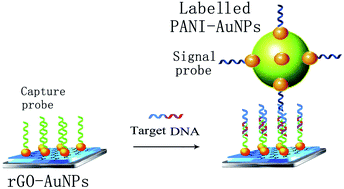Electrochemical measurement of Clostridium tetani using a reduced graphene oxide modified electrode and polyaniline–gold nanoparticle-labelled probe
Abstract
Tetanus is a neuromuscular disease caused by Clostridium tetani exotoxin, which produces muscle spasms, incapacitating the host. Tetanus is especially prevalent during outbreaks of war and earthquakes. Due to the difficulty of assaying anaerobic cultures, a simple, rapid, sensitive and accurate alternative method is desirable. In this study, a new electrochemical method has been developed based on a reduced graphene oxide (rGO) modified electrode and polyaniline–gold nanoparticle (PANI–AuNP) modified probe. The results indicate that the electroactive surface area of the rGO–AuNP modified electrode increased approximately 95.4%, compared to the bare screen-printed electrode (SPE). This electrochemical detection of C. tetani could be completed on a mini-SPE by DPV detection with a limit of 10−15 mol mL−1. Compared with the anaerobic culture method, this new electrochemical method has a sensitivity of 95.3%, a specificity of 97.8%, and displays high consistency (X2 test: p > 0.05). As a result, this new method may be an appropriate technology for point-of-care testing (POCT) of C. tetani infections.


 Please wait while we load your content...
Please wait while we load your content...